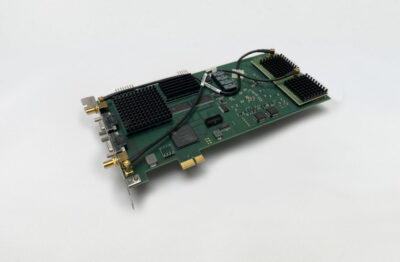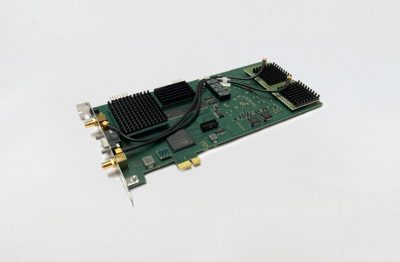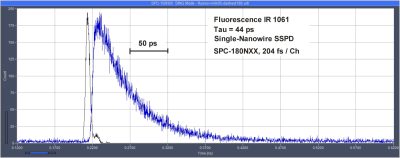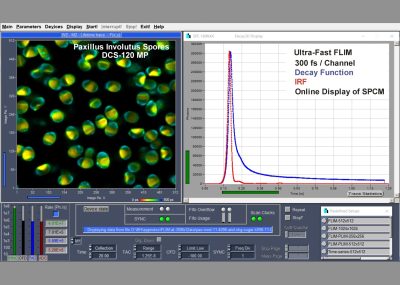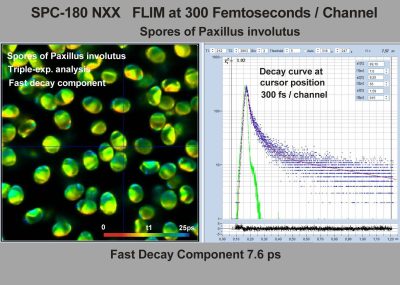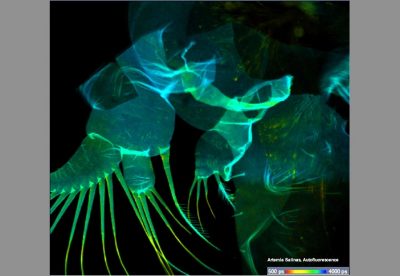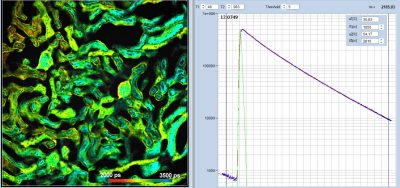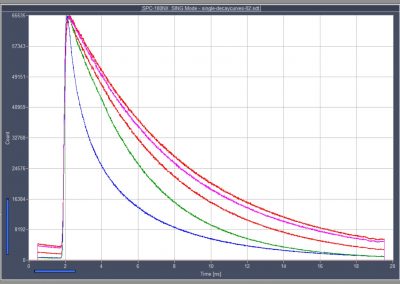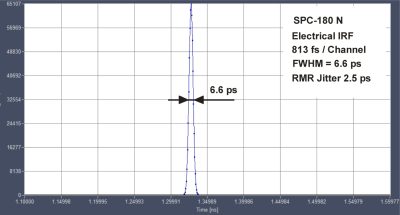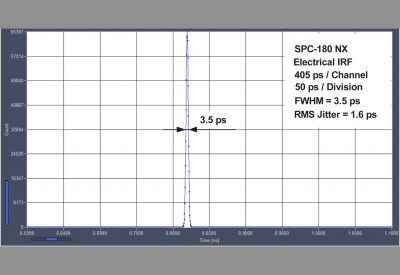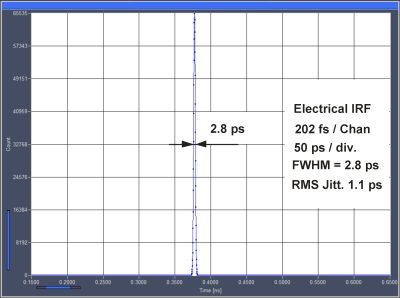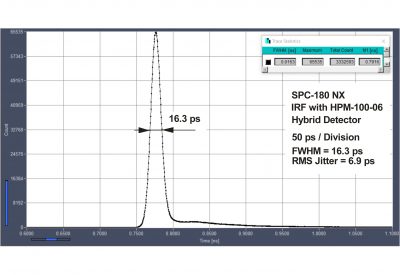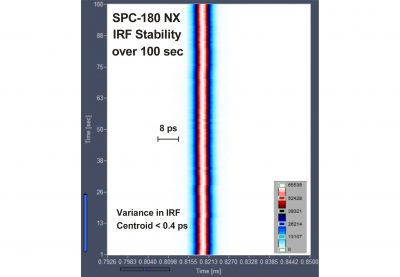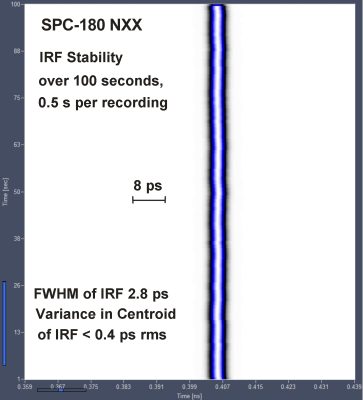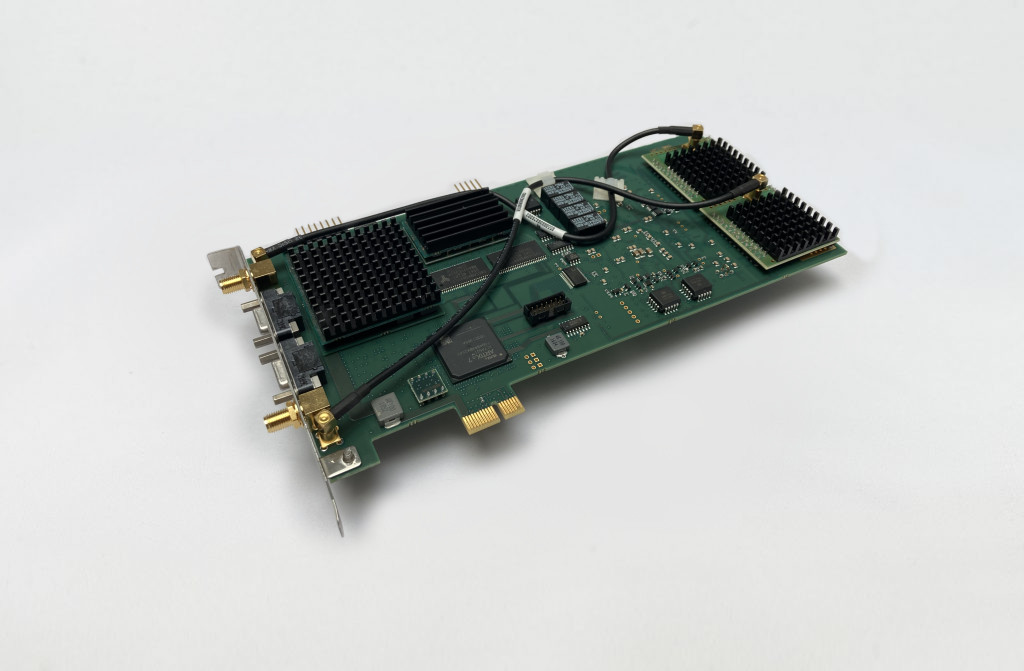
- High-Throughput PCIe Interface
- Unprecedented Time Resolution and Excellent Timing Stability
- Time Channel Width Down to 203 fs
- Internal Timing Jitter (RMS) / IRF Width (FWHM) Down to 1.1 ps / 2.8 ps
- 12 MHz Saturated Count Rate
- -NX and -NXX Versions Ideal for Ultra-Fast HPM (Hybrid) Detectors and Superconducting NbN Detectors
- Precision Fluorescence Decay Recording
- High-Resolution FLIM, Simultaneous FLIM / PLIM and Multi-Wavelength FLIM
- Photon Correlation, Single-Molecule Spectroscopy
- Free Instrument Software for Windows 10 / 11
- Realtime Calculation of FLIM Images, FCS Curves and Decay Curves from FLIM ROIs
- Realtime Fit of FCS Curves
- Link to SPCImage NG Data Analysis
- Parallel Operation of Up to 4 Modules
- Available as Multi-Module Package, e.g. SPC-182NX, SPC-183NX and SPC-184NX
Description
The SPC-180N is a high-end performance module for fluorescence lifetime imaging micrscopy (FLIM) with high-time resolution. The board can be used for fluorescence lifetime measurements, single molecule spectroscopy, FCS and FCCS recording, FLIM, Mosaic FLIM, FLITS, and combined FLIM / PLIM applications. This module is also the basis of FLIM upgrades for various scanning microscopes.
General Information
The SPC-180N modules have ultra-fast timing electronics equivalent to those of the SPC‑150N series. The modules are available in three versions with different time range and time resolution:
Minimum Time Channel Width
SPC-180N: 813 fs
SPC-180NX: 405 fs
SPC-180NXX: 203 fs
Internal Timing Jitter (RMS) / IRF Width (FWHM)
SPC-180N: 2.5 ps / 6.6 ps
SPC-180NX: 1.6 ps / 3.5 ps
SPC-180NXX: 1.1 ps / 2.8 ps
The -NX version, and, especially, the -NXX version have been designed for ultra-fast detectors, SSPDs and ultra-fast hybrid detectors.
All SPC-180N series modules have high-speed PCI-Express (PCIe) interfaces. The new interface achieves extremely high data transfer rates. With the SPC-180N series modules, bus saturation and FIFO overflow in fast FLIM applications are unlikely to occur. To further facilitate fast FLIM, the modules of the SPC-180N series have a fast counter in parallel to the TCSPC timing electronics. This allows the data acquisition software to build up FLIM images, for which the intensity remains linear up to the highest count rates.
All SPC-180N family modules have high-speed PCI-Express (PCIe) interfaces and can be easily installed in nearly all PCs or configured as stand-alone timing unit.
Measurement Software Included
The SPCM operating and measurement software is included with all SPC series modules. SPCM provides online calculation and display (2D, 3D) of data (decay curves, FLIM, FCS, FCCS) acquired in multiple operation modes. SPCM software undergoes active continuous development. SPCM receives frequent updates with new features and bug fixes. Read more…
FLIM and FCS Data Analysis
For advanced fluorescence lifetime imaging (FLIM) and single-curve data analysis, please use SPCImage.
For advanced visualisation and analysis of dynamic effects, please use SPCDynamics.
For advanced fluorescence correlation spectroscopy (FCS) and cross-correlation (FCCS) data analysis, please use Burst Analyzer.
Custom Programming Libraries (DLL, LabVIEW)
For automation and custom software integration, DLLs and LabVIEW drivers are available. Read more…
Specifications
|
SPC-180N |
SPC-180NX |
SPC-180NXX |
|||
|
Photon Channel |
|
||||
|
Principle |
Constant Fraction Discriminator (CFD) |
||||
|
Discriminator Input Bandwidth |
4 GHz |
||||
|
Time Resolution (FWHM/RMS, electr.) |
6.6 ps / 2.5 ps |
< 3.5 ps / 1.6 ps |
< 3 ps / 1.1 ps |
||
|
Variance in Time of IRF max. (RMS) |
< 0.4 ps over 100 s |
||||
|
Optimum Input Voltage Range |
-30 mV to -500 mV |
||||
|
Min. Input Pulse Width |
200 ps |
||||
|
Threshold |
0 to -500 mV |
||||
|
Zero Cross Adjust |
-100 mV to 100 mV |
||||
|
Syncronisation Channel |
|
||||
|
Principle |
Constant Fraction Discriminator (CFD) |
||||
|
Discriminator Input Bandwidth |
4 GHz |
||||
|
Optimum Input Voltage Range |
-30 mV to -500 mV |
||||
|
Min. Input Pulse Width |
200 ps |
||||
|
Threshold |
0 to -500 mV |
||||
|
Frequency Range |
0 to 150 MHz |
||||
|
Frequency Divider |
1, 2, 4 |
||||
|
Zero Cross Adjust |
-100 mV to 100 mV |
||||
|
Time-to-Amplitude Converters / ADCs |
|
||||
|
Principle |
Ramp Generator / Biased Amplifier |
||||
|
TAC Range |
50 ns to 5 µs |
25 ns to 2.5 µs |
12.5 ns to 125 ns |
||
|
Biased Amplifier Gain |
1 to 15 |
||||
|
Biased Amplifier Offset (of TAC Range) |
0 % to 50 % |
||||
|
Time Range incl. Biased Amplifier |
3.3 ns to 5 µs |
1.67 ns to 2.5 µs |
0.834 ns to 125 ns |
||
|
Min. Time Channel Width |
813 fs |
407 fs |
203 fs |
||
|
ADC Principle |
50 ns Flash ADC with Error Correction |
||||
|
Diff. Nonlinerarity |
< 0.5 % RMS, typ. < 1 % peak-peak |
||||
|
Data Acquisition |
Histogram Mode |
||||
|
Method |
on-board multi-dim. histogramming process |
||||
|
Dead Time |
80 ns, independent of computer speed |
||||
|
Saturated Count Rate |
12 MHz |
||||
|
Max. Counts / Time Channel |
16 bits |
||||
|
Overflow Control |
none, stop, repeat and correct |
||||
|
Collection Time |
0.1 µs to 100,000 s |
||||
|
Diplay Interval Time |
10 ms to 100,000 s |
||||
|
Repeat Time |
0.1 µs to 100,000 s |
||||
|
Sequencing Recording |
Programmable Hardware Sequencer, unlimited recording by Memory swapping, in curve mode and scan mode |
||||
|
Syncronisation with Scanning |
Pixel, Line and Frame from Scanning Device |
||||
|
Routing |
7 bit, TTL |
||||
|
Experiment Trigger |
TTL |
||||
|
Data Acquisition |
FIFO / Parameter-Tag Mode |
||||
|
Method |
Time and wavelength tagging of individual photons and continuous writing to disk |
||||
|
Online Display |
Decay functions, FCS, Cross-FCS, PCH MCS Traces |
||||
|
FCS Calculation |
Multi-tau algorithm, online calculation and online fit |
||||
|
Number of Counts of Decay/ Waveform Recording |
unlimited |
||||
|
Dead Time |
80 ns |
||||
|
Saturated Count Rate, Peak |
12 MHz |
||||
|
Sustained Count Rate (Bus Transfer Limit) |
typ. 5 MHz |
||||
|
Max. Counts / Time Channel (Counting Depth) |
unlimited |
||||
|
Output Data Format (ADC / Macrotime / Routing) |
12 / 12 / 4 |
||||
|
FIFO Buffer Capacity (Photons) |
2 * 106 |
||||
|
Macro Timer Resolution, Internal Clock |
25 ns, 12 bit, overflows marked by MOTF entry in data stream |
||||
|
Input Macro Timer Resolution, Clock from Sync |
10 ns to 100 ns, 12 bit, overflow marked by MOTF entry in data stream |
||||
|
Input Curve Control (external Routing) |
4 bit, TTL |
||||
|
External Event Markers |
4 bit, TTL |
||||
|
Input Count Enable Control |
1 bit, TTL |
||||
|
Input Experiment Trigger |
TTL |
||||
|
Data Acquisition |
FIFO / Parameter-Tag Imaging Mode |
||||
|
Method |
Buildingup images from time- and wavelength tagged data |
||||
|
Online Display |
up to 8 Images in different time and wavelength windows |
||||
|
Synchronisation with Scanner |
via Frame Clock, Line Clock and Pixel Clock Pulses |
||||
|
Detector / Wavelength Channels |
1 to 16 |
||||
|
Image resolution (64-bit SPCM Software) |
|
||||
|
No. of Time Channels |
64 |
256 |
1024 |
4096 |
|
|
No. of Pixels, 1 Detector Channel |
4096 x 4096 |
2048 x 2048 |
1024 x 1024 |
512 x 512 |
|
|
No. of Pixels, 16 Detector Channels |
1024 x 1024 |
512 x 512 |
256 x 256 |
128 x 128 |
|
|
Operation Environment |
|
||||
|
PC System |
Windows 8 / 10, > 8 GB RAM, 64 bit operating system recommended |
||||
|
PC Interface |
PCIe |
||||
|
Power Consumption |
approx. 12 W from +12 V |
||||
|
Dimensions |
230 mm x 130 mm x 18 mm |
||||
Downloads
Documents
Datasheets
Applications
Application Notes
- Time-Tag Recording: A New Old Feature of the bh SPC Cards
- FLIM in the FIFO Imaging Mode: Large Images with Small TCSPC Modules
- Recording Z Scans with the DCS-120 Confocal Scanning FLIM System
- Tuneable Excitation FLIM with the LSM 710 Intune System
- An 8-Channel Parallel Multispectral TCSPC FLIM System
- Microsecond Decay FLIM: Combined Fluorescence and Phosphorescence Lifetime Imaging
- Spatially Resolved Recording of Fluorescence-Lifetime Transients by Line- Scanning TCSPC
- Combined Fluorescence and Phosphorescence Lifetime Imaging (FLIM / PLIM) with the Zeiss LSM 710 NLO Microscopes
- TCSPC at Wavelengths from 900 nm to 1700 nm
- Mosaic FLIM: New Dimensions in Fluorescence Lifetime Imaging
- Zeiss BiG-2 GaAsP Detector is Compatible with bh FLIM Systems
- An AFM/NSOM System with Fluorescence Lifetime Imaging
- NSOM FLIM with the Nanonics AFM/NSOM System
- Implantable Fibre-Optical Fluorescence-Lifetime Detection System for in-vivo Applications
- TCSPC Fibre-Probe System with an Exchangeable Tip
- The PZ-FLIM-110 Piezo-Scanning FLIM System
- 80 ps FHWM Instrument Response with ID230 InGaAs SPAD and SPC-150 TCSPC Module
- World Record in TCSPC Time Resolution: Combination of bh SPC-150NX with SCONTEL NbN Detector yields 17.8 ps FWHM
- bh – Abberior Combination Records STED FLIM at Megapixel Resolution
- SPCM Software Runs Online-FLIM at 10 Images per Second
- bh TCSPC Systems Record FLIM with Sutter MOM Microscopes
- Sub-20ps IRF Width from Hybrid Detectors and MCP-PMTs
- Ultra-fast HPM Detectors Improve NAD(P)H FLIM
- TCSPC System Records FLIM of a Rotating Object
- 4.4 ps IRF width of TCSPC with an NbN Superconducting Nanowire Single Photon Detector
- Influence of Magnetic Fields on the IRF of High-Speed Detectors for TCSPC
- Two-Photon FLIM of Mushroom Spores Reveals Ultra-Fast Decay Component
- 273 ps FWHM TCSPC Response with Hamamatsu H15620 NIR PMT
- Lifetime-Intensity Mode Delivers Better FLIM Images
- FLIM at a Time-Channel Width of 300 Femtoseconds
- Ultra-Fast Fluorescence Decay in Scottish Whisky
- Ultra-Fast Fluorescence Decay in Natural Carotenoids
- Ultra-Fast Fluorescence Decay in Malignant Melanoma
- Metabolic FLIM of Macroscopic Objects
- 8.7 ps FWHM IRF Width from Ultrafast SPAD
- A Differential Discriminator for bh TCSPC Modules
- Suppression of Lens Fluorescence in FLIO Images of Cataract Patients
- High-Resolution Multiphoton FLIM Reveals Ultra-Fast Fluorescence Decay in Human Hair
- High Resolution Z-Stack FLIM with the Becker & Hickl DCS-120 Confocal FLIM System
Principles
The bh SPC modules use a multi-dimensional TCSPC principle. The principle is an extension of the classic TCSPC process: A detector detects single photons of a periodic light signal. The TCSPC electronics measures the times of the photons within the signal (excitation) period, and builds up the distribution of the photons over the time of the signal period. The time resolution of the TCSPC process is much higher than the resolution of an analog recording with the same detector: The time of a photon pulse can be determined with a much higher precision than its width.
In extension of the classic process, the bh technique determines additional parameters of the photons, such as wavelength, point of origin within an image area, excitation wavelength, time from an external stimulation of the sample, time within an additional modulation period of the excitation light. The photon distribution is built up over the photon times in the signal period and one or several of these additional parameters. The results of this process are multi-wavelength fluorescence-decay data, fluorescence-lifetime images, multi-wavelength lifetime images, multi-excitation decay data or multi-excitation FLIM data, decay data or FLIM data of fast dynamic changes within a sample, or combined fluorescence / phosphorescence decay data or FLIM / PLIM data. Please see also 'The bh TCSPC Technique'.

